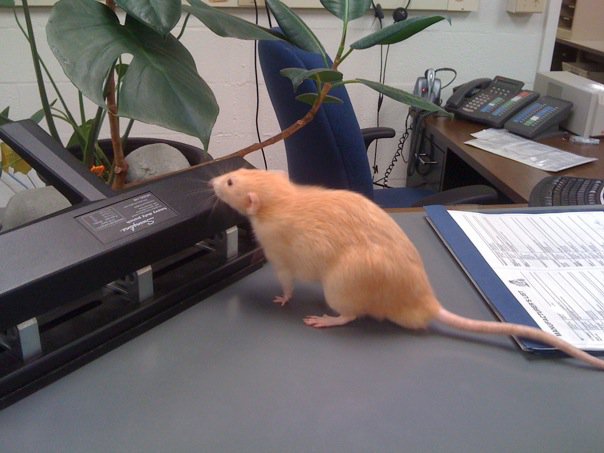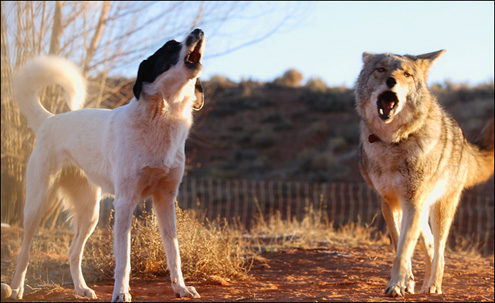If one more person on my blog roll references Lamarck when talking about recent breakthroughs in epigenetics, I'm going to do violence to something.
Double violence if it boils down to: 'Golly gee, was he right all along?!?'
Thursday, March 25, 2010
Wednesday, March 24, 2010
Links for a Wednesday
- A good rundown of the issues with 'organic' food
- Combating Resistance: The Case for a Global Antibiotics Treaty
- What does the human world really look like?
- The Work of Art in the Age of Digital Reproduction.Technology is great (I love Photoshop) but bits aren't magical. If anything, digital media is even more prone to catastrophic failure than physical media. Canvas paintings, for example, can survive a surprising amount of decay and remain 'readable'. But try recovering bits from a harddrive that's been exposed to damp or heat.
Tuesday, March 23, 2010
How to photograph a flower
First, get down closer to the flower's level. A photo will be more interesting if you're level with the plant than towering above it.

Next, have your dog come running over to see what you're looking at.

Adjust your camera's setting. Try a couple test photos. Make sure your black and white dog messes up the white balance and exposure settings.
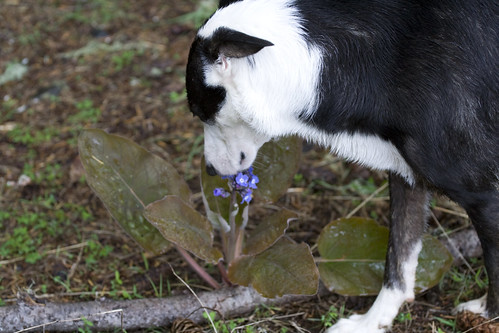
Have your dog lay down out of the shot and focus on the flower again. Have another dog run over to see what all the commotion's about. Make sure your first dog jumps up from her totally reliable down-stay to bossily shove the second dog away from the interesting object you keep staring at.

Finally get both dogs in down stay, take a few damned photos, realize it's overcast and the lighting sucks anyway and give up.


Next, have your dog come running over to see what you're looking at.

Adjust your camera's setting. Try a couple test photos. Make sure your black and white dog messes up the white balance and exposure settings.

Have your dog lay down out of the shot and focus on the flower again. Have another dog run over to see what all the commotion's about. Make sure your first dog jumps up from her totally reliable down-stay to bossily shove the second dog away from the interesting object you keep staring at.

Finally get both dogs in down stay, take a few damned photos, realize it's overcast and the lighting sucks anyway and give up.

Rough-skinned newt

Taricha granulosa
One of my favorite local wildlife. I think it's because they were one of the easiest animals to catch when I was a kid. They're slow, cute, don't bite, and between January and April they're very easy to find. Walk anywhere in the woods and you have to be careful not to step on them.
And yes, even as a kid, I knew to wash my hands after handling them.
Monday, March 22, 2010
Shit
Wednesday, March 17, 2010
EPA's evaluation of pet flea and tick spot-on products
Full disclosure: though I don't work for EPA, all of my salary comes from an EPA grant to my university.
Also, all opinions, inaccuracies, quibbles, quarrels, complaints, awesomeness, etc on this blog are mine alone and do not necessarily reflect those of my employer.
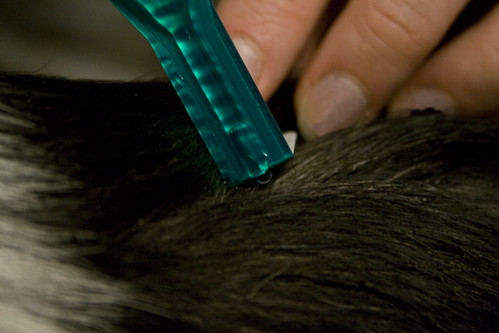
EPA published a press release a few hours ago and held a webinar detailing the results of their year-long analysis of spot-on flea and tick products incident reports.
To give credit where it's due, EPA deserves a pat on the back for having a webinar. True, they didn't advertise it very well, and they kept changing the registration procedure right up until the last minute. But hey. They get a few points from me for the effort for increased transparency. The slides should be available online soon if you missed it (I have copies if you can't wait until then).
The webpage is here and the press release is here. I want to focus on the main bullet points:
Among immediate actions that EPA will pursue are:
1) Requiring manufacturers of spot-on pesticide products to improve
labeling, making instructions clearer to prevent product misuse.
2) Requiring more precise label instructions to ensure proper dosage
per pet weight.
3) Requiring clear markings to differentiate between dog and cat
products, and disallowing similar brand names for dog and cat
products. Similar names may have led to misuse.
4) Requiring additional changes for specific products, as needed,
based on product-specific evaluations.
5) When new products are registered, granting only conditional,
time-limited registrations to allow for post-marketing product
surveillance. If there are incidents of concern associated with
the product, EPA will take appropriate regulatory action.
6) Restricting the use of certain inert ingredients that EPA finds
may contribute to the incidents.
7) Launching a consumer information campaign to explain new label
directions and to help users avoid making medication errors.
Throughout the webinar there was a large emphasis on misuse of these products, ways to minimize misuse, etc. Yes, OK, thanks EPA. Misusing a pesticide can cause health effects. If it's a problem, the solution of making labels more clear is obvious and a good idea. But... tell us something we don't know. Tell us how many incidents happened even when a product was used correctly, and what you're going to do about that. That's what we're really interested in.
It's EPA's mantra: read and follow the label directions. It's good advice up to a point (and I've dealt with plenty of idiots who purposefully put a dog product on their cat, even after reading the directions so I understand trying to drive this point home). However I think it's used too often to relieve them of some responsibility of any negative effect from the products they regulate.
Note that bullets 1, 2, 3, and 7 listed in the press release are all about mitigating consumer misuse. Bullet 5 is just common sense but isn't all that big a change. Bullet 6 annoys me. Why weren't you restricting the use of these mysterious inert ingredients before, EPA? But OK, whatever, you're doing it now. That's good.
Bullet 4 is the most interesting to me. It's also the one that hints that maybe manufactures have some responsibility here besides improving their labels. It's also the bullet that's most vague and non-specific. More details may come out later. EPA made their incident analysis for each individual product available, and I bet there's interesting stuff there. I haven't had a chance to look at them in depth, but I plan to. You should, too. It's not often that EPA publishes incident reports like this. (Notice that they don't list product names. You'll have to look on your product label for an EPA registration number.)
Another impression I got is that EPA is bending over backwards not to single out a specific product or upset the manufacturers. This confuses me. For any other pesticide product, there's a pretty standard way of dealing with any problems. They'll get some complaints about a specific product, they'll look at the complaints and see if they have any merit, inform the manufacturer what they need to change, and then publish a federal register notice talking about any actions they've taken. Browse through the federal register if you don't believe me. This happens all the time, and 99% of the time, it's minor stuff like the manufacture needs to supply additional toxicity info, or change the wording of their label. EPA has no problem publicly singling out products in the past, why the hesitation now? If some of the spot-ons are causing more than their fair share of adverse effects even when used according to label directions, focus on them. Make them change their formulation or percent active ingredient or whatever. Again, with other pesticide products, this happens all the time.
Other important things to note:
During the webinar, one of the speakers Dr. Farwell, the EPA's veterinary toxicologist, mentioned in passing that he uses spot-on products on his own pet dogs. That should tell you something. There's a feeling out there that vets only push these products for the money. It's not true, there is legitimate public health benefit from these products.
EPA only analyzed incident reports from product manufacturers. Some people think this is fishy, but I don't. This is normal for pesticides. Registrants of pesticides are required by law to report to EPA any adverse effects from their products that are reported to them (hint: if you have an adverse effect, call your manufacturer and report it!). However, pet incident reports can also come from other sources that the EPA didn't tap into (for analytical reasons - they had a hard enough time standardizing the reports from different manufacturers). The ASPCA and other pet poison control centers take incident reports, and so does NPIC and some state regulatory bodies. More recently than 2008, there's the vet reporting portal and you can report it directly to EPA by going here clicking on question #1. I hope in the future they'll look at these sources as well.
They're not done with this evaluation. I have a feeling that some of these products will be changing more than just their labels in the next few years. I'm not brave enough to name names, but there's more than one product on that list that I wouldn't miss if it were 'voluntarily canceled'.
Have an opinion about this? Think EPA should ban all spot-on products? Think they should pass the regulation of such to FDA? Think government is interfering too much with the profit margins of the poor manufacturers? EPA set up an email address just for questions and comments relating to this issue: pets@epa.gov
Since that email is likely to be inundated, I would also recommend going to the docket and sending in an official comment. Starting today, there's a 60 day public comment period and EPA is required by law to read (and, I believe, publish) each and every comment sent to them through the docket.
Go to regulations.gov and search for docket ID EPA-HQ-OPP-2010-0229.
Also, all opinions, inaccuracies, quibbles, quarrels, complaints, awesomeness, etc on this blog are mine alone and do not necessarily reflect those of my employer.

(Zelda gets dosed)
EPA published a press release a few hours ago and held a webinar detailing the results of their year-long analysis of spot-on flea and tick products incident reports.
To give credit where it's due, EPA deserves a pat on the back for having a webinar. True, they didn't advertise it very well, and they kept changing the registration procedure right up until the last minute. But hey. They get a few points from me for the effort for increased transparency. The slides should be available online soon if you missed it (I have copies if you can't wait until then).
The webpage is here and the press release is here. I want to focus on the main bullet points:
Among immediate actions that EPA will pursue are:
1) Requiring manufacturers of spot-on pesticide products to improve
labeling, making instructions clearer to prevent product misuse.
2) Requiring more precise label instructions to ensure proper dosage
per pet weight.
3) Requiring clear markings to differentiate between dog and cat
products, and disallowing similar brand names for dog and cat
products. Similar names may have led to misuse.
4) Requiring additional changes for specific products, as needed,
based on product-specific evaluations.
5) When new products are registered, granting only conditional,
time-limited registrations to allow for post-marketing product
surveillance. If there are incidents of concern associated with
the product, EPA will take appropriate regulatory action.
6) Restricting the use of certain inert ingredients that EPA finds
may contribute to the incidents.
7) Launching a consumer information campaign to explain new label
directions and to help users avoid making medication errors.
Throughout the webinar there was a large emphasis on misuse of these products, ways to minimize misuse, etc. Yes, OK, thanks EPA. Misusing a pesticide can cause health effects. If it's a problem, the solution of making labels more clear is obvious and a good idea. But... tell us something we don't know. Tell us how many incidents happened even when a product was used correctly, and what you're going to do about that. That's what we're really interested in.
It's EPA's mantra: read and follow the label directions. It's good advice up to a point (and I've dealt with plenty of idiots who purposefully put a dog product on their cat, even after reading the directions so I understand trying to drive this point home). However I think it's used too often to relieve them of some responsibility of any negative effect from the products they regulate.
Note that bullets 1, 2, 3, and 7 listed in the press release are all about mitigating consumer misuse. Bullet 5 is just common sense but isn't all that big a change. Bullet 6 annoys me. Why weren't you restricting the use of these mysterious inert ingredients before, EPA? But OK, whatever, you're doing it now. That's good.
Bullet 4 is the most interesting to me. It's also the one that hints that maybe manufactures have some responsibility here besides improving their labels. It's also the bullet that's most vague and non-specific. More details may come out later. EPA made their incident analysis for each individual product available, and I bet there's interesting stuff there. I haven't had a chance to look at them in depth, but I plan to. You should, too. It's not often that EPA publishes incident reports like this. (Notice that they don't list product names. You'll have to look on your product label for an EPA registration number.)
Another impression I got is that EPA is bending over backwards not to single out a specific product or upset the manufacturers. This confuses me. For any other pesticide product, there's a pretty standard way of dealing with any problems. They'll get some complaints about a specific product, they'll look at the complaints and see if they have any merit, inform the manufacturer what they need to change, and then publish a federal register notice talking about any actions they've taken. Browse through the federal register if you don't believe me. This happens all the time, and 99% of the time, it's minor stuff like the manufacture needs to supply additional toxicity info, or change the wording of their label. EPA has no problem publicly singling out products in the past, why the hesitation now? If some of the spot-ons are causing more than their fair share of adverse effects even when used according to label directions, focus on them. Make them change their formulation or percent active ingredient or whatever. Again, with other pesticide products, this happens all the time.
Other important things to note:
During the webinar, one of the speakers Dr. Farwell, the EPA's veterinary toxicologist, mentioned in passing that he uses spot-on products on his own pet dogs. That should tell you something. There's a feeling out there that vets only push these products for the money. It's not true, there is legitimate public health benefit from these products.
EPA only analyzed incident reports from product manufacturers. Some people think this is fishy, but I don't. This is normal for pesticides. Registrants of pesticides are required by law to report to EPA any adverse effects from their products that are reported to them (hint: if you have an adverse effect, call your manufacturer and report it!). However, pet incident reports can also come from other sources that the EPA didn't tap into (for analytical reasons - they had a hard enough time standardizing the reports from different manufacturers). The ASPCA and other pet poison control centers take incident reports, and so does NPIC and some state regulatory bodies. More recently than 2008, there's the vet reporting portal and you can report it directly to EPA by going here clicking on question #1. I hope in the future they'll look at these sources as well.
They're not done with this evaluation. I have a feeling that some of these products will be changing more than just their labels in the next few years. I'm not brave enough to name names, but there's more than one product on that list that I wouldn't miss if it were 'voluntarily canceled'.
Have an opinion about this? Think EPA should ban all spot-on products? Think they should pass the regulation of such to FDA? Think government is interfering too much with the profit margins of the poor manufacturers? EPA set up an email address just for questions and comments relating to this issue: pets@epa.gov
Since that email is likely to be inundated, I would also recommend going to the docket and sending in an official comment. Starting today, there's a 60 day public comment period and EPA is required by law to read (and, I believe, publish) each and every comment sent to them through the docket.
Go to regulations.gov and search for docket ID EPA-HQ-OPP-2010-0229.
Tuesday, March 16, 2010
Tuesday is for links
- LA restaurant caught serving whale. With my fave quote of the year so far:
"Someone should not be able to walk into a restaurant and order a plate of an endangered species," U.S. Attorney Andre Birotte Jr. said.
- Attention dog trainers: want to make money off of others' misfortune? Get in on the ground floor of a growing industry and train a bedbug sniffing dog. The bedbug resurgence is going to get a lot worse before it gets better.
"Homeowners tend an estimated 40 million acres of turf (Environmental Science and Technology, 2005). If classified as a crop, lawns would rank as the fifth largest in the country on the basis of area after corn, soybeans, wheat, and hay (USDA, 1992). Fertilizers applied to lawns are roughly equivalent to the application rates for row crops (Barth, 1995a). Urban lawns receive an estimated five to seven pounds of pesticides per acre annually (Schueler, 1995b)."
Friday, March 12, 2010
wishing so hard for opposable thumbs
... but doing fine without them. She does this only when there are loose, biscuit-like treats in the kong and gravity will help her get at them.
(I just downloaded an app for my phone that allows it to take video. I'll try to keep the postings of blurry vids of my pets to a minimum, but you can always catch every low-rez minute at my Youtube.)
(I just downloaded an app for my phone that allows it to take video. I'll try to keep the postings of blurry vids of my pets to a minimum, but you can always catch every low-rez minute at my Youtube.)
Thursday, March 11, 2010
Shelter cats compete in cat show - win ribbons
http://gazettetimes.com/news/local/article_13ce4746-2cab-11df-bacb-001cc4c002e0.html
This is the shelter I got Zelda from, so I'm quite biased when I say they are an excellent private no-kill shelter. Kudos to them for staying creative in advertising the animals for adoption.
"Bathed and gussied up, eight shelter cats competed last weekend in a cat club show at the Linn County Fair & Expo Center, and all of them took home at least one ribbon. The judges had no idea the cats were from SafeHaven Humane Society in Albany, so judged them equally against the cat fanciers’ entrants."
This is the shelter I got Zelda from, so I'm quite biased when I say they are an excellent private no-kill shelter. Kudos to them for staying creative in advertising the animals for adoption.
EPA finally doing something about pet spot-on products?
Update: They finally put this information on their website... a whole 2 days before the event:
http://www.epa.gov/pesticides/health/spot_on_webinar.html
It's been almost a year since EPA's initial press release and they're finally giving some hints that they might be ready for some action. They're holding a webinar next week that's open for the public. I'll be watching it and I'll post an update here if anything interesting happens. This might be worthwhile to attend for anyone who uses or wants to use a spot-on product. Or it might be a boring waste of time. That's the fun part about dealing with the government, you never know!
(Note that EPA only regulates some-spot ons, like Frontline and Advantage the type that essentially stay on the surface of the skin. Any products like Advantage Multi, or Capstar, that are either given orally or that absorb through the skin into the blood stream, are considered drugs and are regulated by FDA).
I don't think EPA has posted this information anywhere online (I got the announcement from an email listserv). Below is the complete text in case anyone is interested:
"On Wednesday, March 17, 2010, from 4:00 pm - 6:00 p.m., ET, the U.S. Environmental Protection Agency will hold a public meeting via Webinar, entitled EPA's Evaluation of Pet Spot-On Products: Analysis and Mitigation Plan. Last spring, following a significant increase in incident reports associated with pet spot-on products in 2008, EPA requested additional information from the pet spot-on pesticide registrants and conducted an intensive evaluation of those incidents and products. During the Webinar, the public will have an opportunity to ask questions about EPA's findings and plans to protect pets. The Webinar is free and no preregistration is necessary to join the conference.
If this is your first time participating in an EPA Webinar through the EPA Portal, we recommend that you download the software prior to March 17. Go to http://hawkeye.epa.gov/imtapp/app/nuf_sys.uix and click on the icon under "Run"(on the right-hand side of the Web page). If you see a run or installation pop-up, please click Yes, Run, or Allow. This is a one-time add-on that is needed to run the Web conference software. If your screen flickers or goes black during this step, it is normal.
On March 17, participants can log in to the Webinar and conference call beginning at 3:50 pm.
1. Using Internet Explorer, go to http://portal.epa.gov/webconference. In the JOIN CONFERENCE box on the right-hand side of the Web page, enter the Conference ID 56381.
2. Leave the Conference Key blank, and enter your full name and e-mail address where requested. Press JOIN CONFERENCE. You will be able to view the presentation once the meeting begins.
3. Dial toll free into the conference on your telephone in order to hear the EPA speakers. Call the Conference number: 1-866-229-3188, then enter conference code 703 308 8059 and press the # sign.
All telephone lines will be muted during the Webinar. If you wish to ask questions, please e-mail them to syed.hamaad@epa.gov during the meeting and they will be forwarded to the presenters. We will answer as many questions as possible during the allotted time.
Please note that the Web conference tool will only work on a PC computer. Please use Internet Explorer as your browser. It is recommended that you change your screen resolution before joining the Webinar. To adjust the resolution:
1. Right-click on your Desktop
2. Go to "Properties"
3. Go to the "Settings" tab
4. Go to the highest screen resolution by pulling the tab in the lower-left corner toward "More." Click OK. 1024 x 768 is the best
***********************************************
EPA distributes its Pesticide Program Updates to external stakeholders and citizens who have expressed an interest in pesticide activities and decisions. This update service is part of EPA's continuing effort to improve public access to Federal pesticide information."
http://www.epa.gov/pesticides/health/spot_on_webinar.html
It's been almost a year since EPA's initial press release and they're finally giving some hints that they might be ready for some action. They're holding a webinar next week that's open for the public. I'll be watching it and I'll post an update here if anything interesting happens. This might be worthwhile to attend for anyone who uses or wants to use a spot-on product. Or it might be a boring waste of time. That's the fun part about dealing with the government, you never know!
(Note that EPA only regulates some-spot ons, like Frontline and Advantage the type that essentially stay on the surface of the skin. Any products like Advantage Multi, or Capstar, that are either given orally or that absorb through the skin into the blood stream, are considered drugs and are regulated by FDA).
I don't think EPA has posted this information anywhere online (I got the announcement from an email listserv). Below is the complete text in case anyone is interested:
"On Wednesday, March 17, 2010, from 4:00 pm - 6:00 p.m., ET, the U.S. Environmental Protection Agency will hold a public meeting via Webinar, entitled EPA's Evaluation of Pet Spot-On Products: Analysis and Mitigation Plan. Last spring, following a significant increase in incident reports associated with pet spot-on products in 2008, EPA requested additional information from the pet spot-on pesticide registrants and conducted an intensive evaluation of those incidents and products. During the Webinar, the public will have an opportunity to ask questions about EPA's findings and plans to protect pets. The Webinar is free and no preregistration is necessary to join the conference.
If this is your first time participating in an EPA Webinar through the EPA Portal, we recommend that you download the software prior to March 17. Go to http://hawkeye.epa.gov/imtapp/app/nuf_sys.uix and click on the icon under "Run"(on the right-hand side of the Web page). If you see a run or installation pop-up, please click Yes, Run, or Allow. This is a one-time add-on that is needed to run the Web conference software. If your screen flickers or goes black during this step, it is normal.
On March 17, participants can log in to the Webinar and conference call beginning at 3:50 pm.
1. Using Internet Explorer, go to http://portal.epa.gov/webconference. In the JOIN CONFERENCE box on the right-hand side of the Web page, enter the Conference ID 56381.
2. Leave the Conference Key blank, and enter your full name and e-mail address where requested. Press JOIN CONFERENCE. You will be able to view the presentation once the meeting begins.
3. Dial toll free into the conference on your telephone in order to hear the EPA speakers. Call the Conference number: 1-866-229-3188, then enter conference code 703 308 8059 and press the # sign.
All telephone lines will be muted during the Webinar. If you wish to ask questions, please e-mail them to syed.hamaad@epa.gov during the meeting and they will be forwarded to the presenters. We will answer as many questions as possible during the allotted time.
Please note that the Web conference tool will only work on a PC computer. Please use Internet Explorer as your browser. It is recommended that you change your screen resolution before joining the Webinar. To adjust the resolution:
1. Right-click on your Desktop
2. Go to "Properties"
3. Go to the "Settings" tab
4. Go to the highest screen resolution by pulling the tab in the lower-left corner toward "More." Click OK. 1024 x 768 is the best
***********************************************
EPA distributes its Pesticide Program Updates to external stakeholders and citizens who have expressed an interest in pesticide activities and decisions. This update service is part of EPA's continuing effort to improve public access to Federal pesticide information."
Office visitor
"Why don't they just shoot them?"
The title of this post is what my co-worker (a vegetarian and self-described "bleeding heart") said when I showed her the label for this new pesticide product:
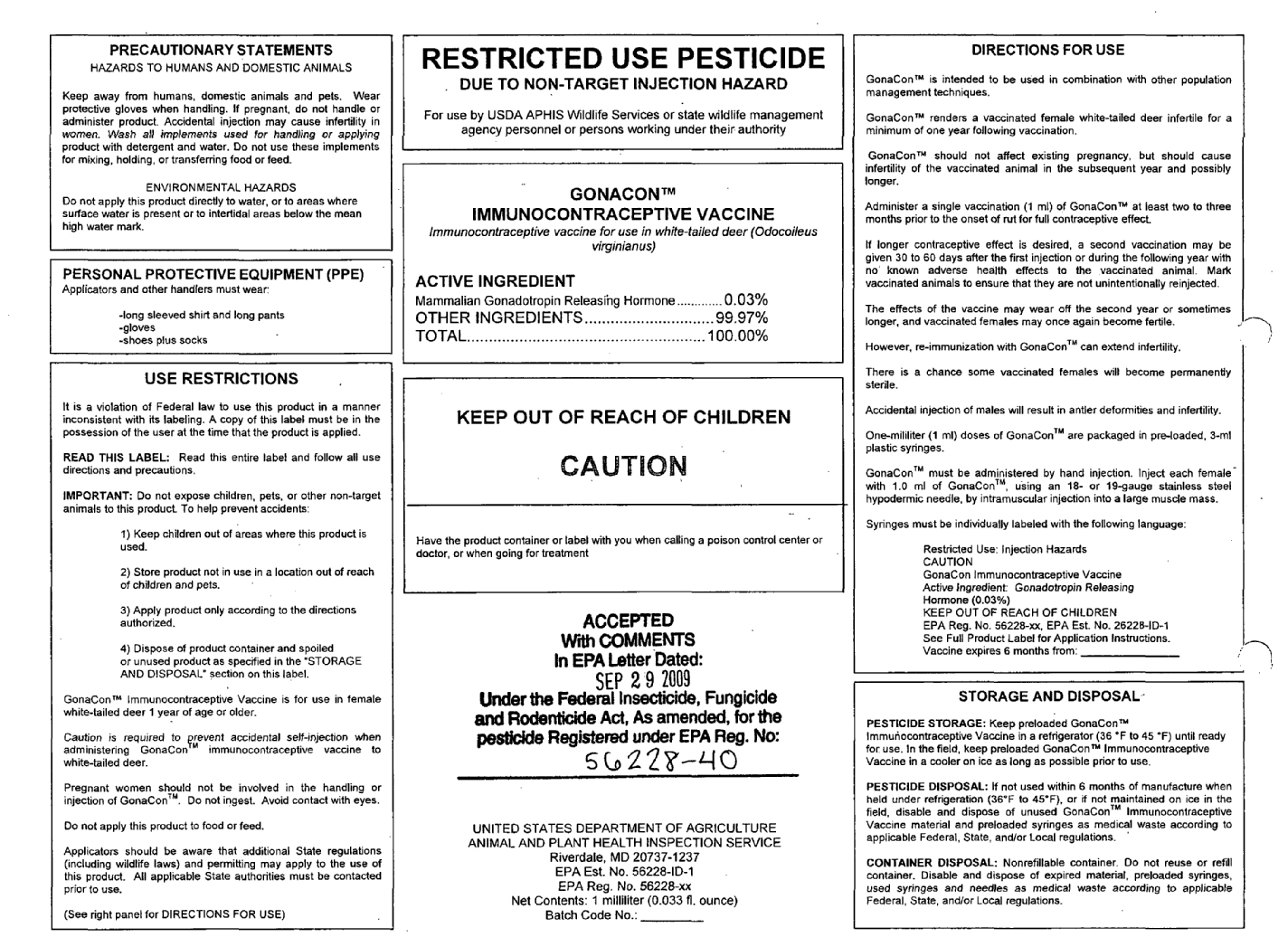
You may have heard the rumors that USDA was considering contraception as population control for deer (and wild horses and goats). They're apparently moving forward with this plan if they bothered to go through the process of registering a product with EPA (which confuses me - vaccines are NEVER registered as pesticides, they fall under FDA's jurisdiction. Why the exception for this one?)
Note that this vaccine can only be applied by hand. That means the animal first has to be trapped or snared, leading to great stress on the animal. Not to mention being extremely expensive.
It's only guaranteed to last for a year. Depending on life expectancy, it's safe to estimate that you'd have to treat the same individuals at least several times in their life.
USDA cites "great public interest" for their reason for pursuing this form of population control. I believe it. "Great public interest" was also the reason USDA pursued and eventually implemented the incredibly flawed National Organic Standards. I appreciate a government agency that's willing to listen to the public. But this is just ridiculous.
Hunting is known to be very effective for deer population control. Not only does it NOT require state or federal money to implement (and in fact generates money through purchase of licenses and tags), it is arguably more humane than trapping/snaring/tranquilizing. It's certainly more humane than starvation, and gives the hunter and his/her family a source of environmentally friendly protein to eat. This sounds like win-win to me.
NPR ran a story recently about this type of special hunt in Connecticut where deer had reached densities of up to 60 per square mile. (Also, do you notice that many wildlife biologists are also hunters/pro-hunting? I thought it was just an Oregon thing, but apparently not).
I do understand people's concern about risks. Some of these parks are very close to houses. Maybe contraception could be useful in small, isolated areas where there's no safe way to discharge a firearm. But, forgive me for being so blunt, if you're going to go to the trouble of trapping or tranqing an animal, why not just kill it right there? Why submit them to multiple trapping and handling and then releasing them back into habitat where they'll still be at risk of starvation?
I've worked for USDA. They can't even afford to maintain their Forest Service roads or rest areas even with fees and even in high traffic areas. Where are they going to get the money to implement contraceptive-based population control program that actually works?
One way or the other, whether it's cruelty through neglect because we removed their natural predators, or hitting them with cars, or trapping and vaccinating or relocating or hunting, humans are going to intervene in these animals lives. We have to choose the most humane way to do so. I have a feeling that hunting is still under-utilized for population control simply because so many people are thoughtlessly anti-hunting.
Dear USDA: Spend some of the money going toward this whole program on educating the public about hunting. Maybe show some ribby, tick-infested deer and their dying fawns staggering through the park they've denuded of vegetation and getting hit by cars during their desperate search for food. Maybe it will get through to some people that hunting is not necessarily evil.

Click to enlarge. Sorry for the blurriness. This is a screen grab of a scan of a photocopy. Thanks, EPA. You can access the original by going here and searching for EPA registration number 56228-40 or by going to regulations.gov and searching for docket number EPA-HQ-OPP-2009-0776
You may have heard the rumors that USDA was considering contraception as population control for deer (and wild horses and goats). They're apparently moving forward with this plan if they bothered to go through the process of registering a product with EPA (which confuses me - vaccines are NEVER registered as pesticides, they fall under FDA's jurisdiction. Why the exception for this one?)
Note that this vaccine can only be applied by hand. That means the animal first has to be trapped or snared, leading to great stress on the animal. Not to mention being extremely expensive.
It's only guaranteed to last for a year. Depending on life expectancy, it's safe to estimate that you'd have to treat the same individuals at least several times in their life.
USDA cites "great public interest" for their reason for pursuing this form of population control. I believe it. "Great public interest" was also the reason USDA pursued and eventually implemented the incredibly flawed National Organic Standards. I appreciate a government agency that's willing to listen to the public. But this is just ridiculous.
Hunting is known to be very effective for deer population control. Not only does it NOT require state or federal money to implement (and in fact generates money through purchase of licenses and tags), it is arguably more humane than trapping/snaring/tranquilizing. It's certainly more humane than starvation, and gives the hunter and his/her family a source of environmentally friendly protein to eat. This sounds like win-win to me.
NPR ran a story recently about this type of special hunt in Connecticut where deer had reached densities of up to 60 per square mile. (Also, do you notice that many wildlife biologists are also hunters/pro-hunting? I thought it was just an Oregon thing, but apparently not).
I do understand people's concern about risks. Some of these parks are very close to houses. Maybe contraception could be useful in small, isolated areas where there's no safe way to discharge a firearm. But, forgive me for being so blunt, if you're going to go to the trouble of trapping or tranqing an animal, why not just kill it right there? Why submit them to multiple trapping and handling and then releasing them back into habitat where they'll still be at risk of starvation?
I've worked for USDA. They can't even afford to maintain their Forest Service roads or rest areas even with fees and even in high traffic areas. Where are they going to get the money to implement contraceptive-based population control program that actually works?
One way or the other, whether it's cruelty through neglect because we removed their natural predators, or hitting them with cars, or trapping and vaccinating or relocating or hunting, humans are going to intervene in these animals lives. We have to choose the most humane way to do so. I have a feeling that hunting is still under-utilized for population control simply because so many people are thoughtlessly anti-hunting.
Dear USDA: Spend some of the money going toward this whole program on educating the public about hunting. Maybe show some ribby, tick-infested deer and their dying fawns staggering through the park they've denuded of vegetation and getting hit by cars during their desperate search for food. Maybe it will get through to some people that hunting is not necessarily evil.
Wednesday, March 10, 2010
dog and coyote howling together
I don't know how many people read The Daily Coyote , but it seems to get a sizable audience.
I'm very skeptical of anyone keeping a wild or hybrid as a pet, but the author of this blog is an example of how it can be done right. I've read her book. Her success (and it wasn't an easy success, either) is probably only because of her unique situation.
The images of Charlie interacting with his dog and cat companions fascinate me. Whatever my mixed feelings of keeping a coyote as a pet, I can't get enough of these photos .
I'm very skeptical of anyone keeping a wild or hybrid as a pet, but the author of this blog is an example of how it can be done right. I've read her book. Her success (and it wasn't an easy success, either) is probably only because of her unique situation.
The images of Charlie interacting with his dog and cat companions fascinate me. Whatever my mixed feelings of keeping a coyote as a pet, I can't get enough of these photos .
Tuesday, March 9, 2010
Food
I must link this here because a) I am apparently too lazy to generate my own blog content and am only able to link to interesting things I find and b) to find this later, c) because I love stats graphics and d) hey, food economics, yo.

I've been under the impression that a much larger proportion of subsidies went to grain crops like corn. Hmm. Yet another reason not to buy steak from the supermarket?

I've been under the impression that a much larger proportion of subsidies went to grain crops like corn. Hmm. Yet another reason not to buy steak from the supermarket?
Wednesday, March 3, 2010
In the 'why didn't I think of this first' catagory
Caddisfly jewelry:
http://www.blaghag.com/2010/02/when-art-meets-biology-caddisfly.html
The creek near the house I grew up in was full of caddisfly larvae, along with lots of other wildlife (it was a very healthy stream). Dad and I would set up aquariums and fill them with kidnapped creatures (we always returned them after a week or two). We could have done this ages ago.
I wonder if they 'helped' the larvae design their homes by present them with different types of stones during the building process, or just gave them a pile of gold and stones and let them figure it out themselves.
http://www.blaghag.com/2010/02/when-art-meets-biology-caddisfly.html
The creek near the house I grew up in was full of caddisfly larvae, along with lots of other wildlife (it was a very healthy stream). Dad and I would set up aquariums and fill them with kidnapped creatures (we always returned them after a week or two). We could have done this ages ago.
I wonder if they 'helped' the larvae design their homes by present them with different types of stones during the building process, or just gave them a pile of gold and stones and let them figure it out themselves.
Tuesday, March 2, 2010
David Malki continues to be a genius
Most online comic creators would be content to simply have a popular comic.
But he has to keep pushing the envelop with his "creativity" and such.
My eyes are a little sore now.
But he has to keep pushing the envelop with his "creativity" and such.
My eyes are a little sore now.
Subscribe to:
Posts (Atom)

